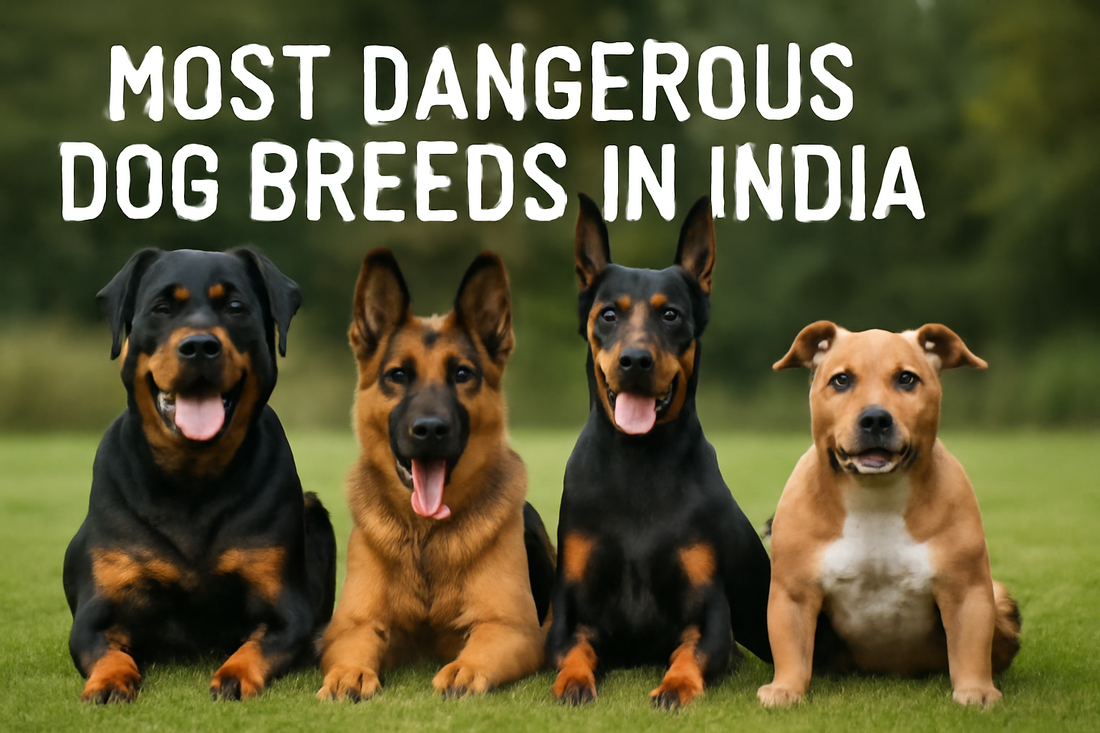When people think of dogs, the image that usually comes to mind is one of wagging tails, loyal companionship, and unconditional love. But not every breed is suited for every home. Some dogs, because of their immense strength, territorial instincts, and potential for aggression, are counted among the most dangerous dog breeds.
This doesn’t mean these animals are inherently bad. In fact, many of them are loving and gentle with the right parents. What it does mean is that they require a level of training, control, and responsibility that goes far beyond what the average pet parent might expect.
In India, where urban spaces are crowded, secure fencing is often overlooked, and professional dog training remains limited, owning such breeds becomes even more complex. Globally, discussions about the most dangerous dog in the world often include the Pit Bull, Rottweiler, or Doberman, but each breed’s temperament depends heavily on its upbringing and environment. That said, some dogs have the combination of physical power, strong bite force, and protective drive that can turn dangerous if not handled properly.
Below is a closer look at some of the most dangerous dogs found in India along with their traits, their risks, and why they require such experienced care.
Most Dangerous Dog Breeds in India
1. Bully Kutta

Often called the “Beast from the East,” the Bully Kutta is a massive mastiff-type breed native to the Punjab and Sindh regions. Traditionally used for guarding and sometimes in illegal fighting rings, they have immense strength and a bite force estimated over 300 PSI.
Bully Kuttas are fearless, dominant, and territorial - qualities that make them excellent guard dogs in rural settings, but a challenge in urban homes. Inexperienced dog parents often struggle with their strong-willed nature.
2. Rajapalayam

Named after the town of Rajapalayam in Tamil Nadu, this tall, elegant sighthound was once used to guard palaces and hunt wild boar. Beneath its graceful build lies a fierce protector.
Rajapalayams are deeply loyal to their families but can be aloof or aggressive toward strangers. Their short, single coat suits the Indian climate perfectly, but their protective instinct needs to be channelled through early training.
3. Gaddi Kutta

From the Himalayan states of Himachal Pradesh and Uttarakhand, the Gaddi Kutta is a powerful mountain dog traditionally used to guard sheep and goats from leopards and bears.
Their thick double coat keeps them warm in freezing temperatures but can make them uncomfortable in hot plains. They are independent thinkers, which can make training a challenge, and their protective instincts are strong enough to make them wary of outsiders.
4. Kombai

The Kombai, another native of Tamil Nadu, is smaller than the Rajapalayam but stockier and more aggressive by nature. Historically used to guard forts and chase down intruders, this breed has a fearless temperament and a natural suspicion of strangers. Kombais bond strongly with their families, but their territorial nature means they’re not ideal for homes with frequent visitors.
5. Rampur Greyhound

Bred in the Rampur region of Uttar Pradesh by royal families, this Indian sighthound combines speed with strength. They were originally used for hunting jackals and big game, which gave them a high prey drive. While loyal to their parents, they can be unpredictable around small animals and require secure, high-fenced spaces to run.
6. Mudhol Hound

Also known as the Caravan Hound, the Mudhol is native to Karnataka and Maharashtra. This slim but muscular dog has been used for centuries as a hunting companion. They are alert, fast, and suspicious of strangers, making them good watchdogs. However, their independent streak means they don’t respond well to harsh training methods.
7. Rottweiler

The Rottweiler may be German in origin, but it’s one of the most popular guard dog breeds in Indian cities. Known for their calm confidence, Rottweilers have a bite force of about 328 PSI and a natural protective instinct.
In India, they often struggle in households that underestimate their exercise and training needs, which can lead to aggression.
8. German Shepherd

German Shepherds are perhaps the most recognized working dogs in India, used by police and military units across the country.
With a bite force of around 238 PSI and sharp intelligence, they can excel in obedience and protection work. In Indian homes, they need plenty of exercise and mental stimulation to prevent restlessness.
9. Doberman Pinscher

The Doberman’s sleek frame and alert posture make it a favorite guard dog in Indian households. They were bred in Germany as personal protectors, and their loyalty and speed are unmatched.
In India, Dobermans adapt well to the climate but need consistent socialization to prevent them from becoming overly aggressive toward strangers.
10. Pit Bull Terrier

The American Pit Bull Terrier has a controversial reputation worldwide, and in India it’s no different. They are muscular, determined, and can have a bite force of around 235 PSI.
Well-trained Pit Bulls can be affectionate and playful, but their strength and stamina make them dangerous in the wrong hands, especially if provoked or poorly socialized.
11. Labrador Retriever

Yes, Labradors can be dangerous too. While Labradors are known for their friendly temperament, they actually top bite incident reports in several Indian cities. This isn’t because they’re inherently aggressive, it’s because they’re one of the most common breeds here.
A poorly trained Labrador with pent-up energy can become excitable and rough, especially around children.
Why They’re Called “Dangerous”
The breeds on this list aren’t automatically aggressive, but they have the physical power, protective instinct, and bite force to cause harm if something goes wrong.
Many of them were bred for guarding, hunting, or herding which are jobs that required decisiveness and courage. Inexperienced parents, cramped living spaces, and lack of proper training can turn those same traits into problems.
In the right environment, even the most dangerous dogs in the world can be gentle, devoted companions. But they demand respect, commitment, and a clear understanding of what they need to thrive, especially in India’s diverse climates and living conditions.
How to Train and Manage Powerful Breeds in India
Training a strong, protective breed in India requires patience, consistency, and a clear understanding of the dog’s instincts.
Early socialization such as exposing the dog to different people, animals, and environments, helps prevent fear-based aggression.
Positive reinforcement works better than punishment, especially with intelligent breeds like German Shepherds and Mudhol Hounds.
For dominant breeds like the Bully Kutta or Rottweiler, parents must establish themselves as calm, confident leaders without resorting to harsh discipline.
Many of these dogs also need mental stimulation via puzzle toys, obedience drills, or scent games in order to prevent boredom-related misbehavior.
Also Read: Small Dog Breeds in India
Ideal Living Conditions for these Dog Breeds in India
Most of these breeds are large and energetic, which means they aren’t suited to small apartments unless the owner is exceptionally committed to exercise and training.
Native breeds like the Rajapalayam, Kombai, and Mudhol Hound are better adapted to Indian heat, while Himalayan breeds like the Gaddi Kutta fare best in cooler climates.
Rottweilers, Dobermans, and German Shepherds can adapt to various regions but still need space to move freely and a secure, fenced yard.
Common Mistakes Indian Dog Parents Make
Many incidents involving the most dangerous dogs in India happen because their parents misunderstand or overlook the breed’s needs.
Some mistakes are more common than others:
1. Choosing for looks rather than lifestyle
Parents sometimes bring home a powerful breed for status or security without considering whether they have the space, time, or experience to manage it.
2. Poor socialization
Breeds with strong guarding instincts need early, positive exposure to people, places, and other animals. Without it, they can become overly suspicious.
3. Not enough exercise or mental activity
High-energy dogs need more than a short daily walk. Without proper outlets, they can develop destructive or aggressive behaviors.
4. Harsh or inconsistent training
Yelling, hitting, or changing the rules confuses the dog and damages trust. Calm, consistent guidance works far better.
5. Ignoring climate and environment
Some breeds struggle in certain parts of India and for obvious reasons as well. For example, thick-coated mountain dogs in the heat of the plains.
6. Treating the dog like a guard post instead of a companion
Isolation or constant chaining can make any breed frustrated and reactive.
Conclusion
As we mentioned earlier as well, the most dangerous dogs in the world, and even in India, are not dangerous by default. They become risky when their strength and instincts aren’t balanced by proper care, training, and respect. Whether it’s a native guardian like the Bully Kutta or an imported protector like the Rottweiler, the responsibility always rests on the owner’s shoulders.
With the right approach, even the most powerful breeds can be loyal, loving companions who protect without posing a threat. But they demand commitment, patience, and a willingness to meet their needs, every single day.




